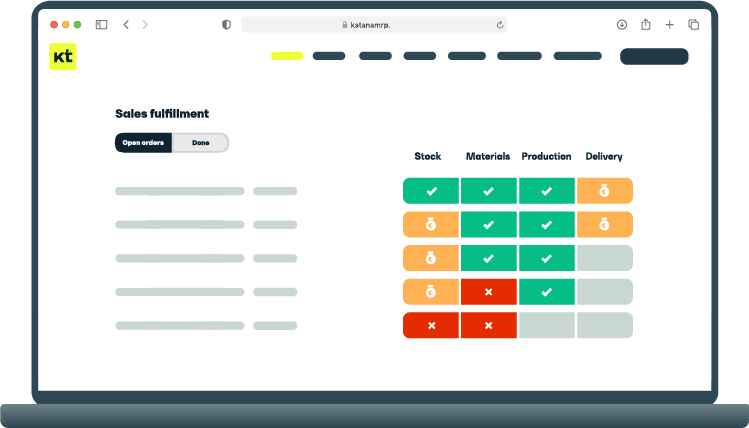Marketing for manufacturers — convert raw materials to products and leads to sales

When it comes to marketing, people generally fall into one of two groups. One group thinks it’s the best thing since sliced bread, and the other considers it something annoying that businesses spend too much time and money on.
As with most things, the reality lies somewhere in between — putting marketing above product development is not a sustainable strategy that delivers a lot of repeat customers. But swapping your marketing strategy with a philosophy based on the old adage “build it and they will come” isn’t going to fill your stores with customers either.
The truth is that marketing is an essential part of any business and integral to its success. And while you should definitely have a product or a service that provides value to your customers, just relying on word of mouth, especially in the start, isn’t going to cut it.
This article will explore the world of marketing for manufacturing companies. We’ll take a look at the strategies, the challenges, the best practices, and more.
There’s a lot to go through, so without further ado, let’s dive in.
What is marketing for manufacturing?

Manufacturing marketing is the process of creating and executing a plan to promote and sell products to customers. The goal of manufacturing marketing is to generate sales and build brand awareness.
There are many different aspects to consider when developing a manufacturing marketing plan, including target markets, product positioning, pricing, promotion, and distribution. A well-executed manufacturing marketing plan can help to increase sales, expand into new markets, and build brand recognition.
The importance of marketing
The marketing function in a manufacturing company is responsible for creating demand for the products that the company produces. Marketing plays a vital role in ensuring that the items a company offers are known and used by potential customers. Marketing also helps build customer relationships, which can result in repeat business.
Manufacturers can use many different channels for marketing their products, including advertising, public relations, direct marketing, and online marketing. It is important that they select the right mix of marketing activities to reach their target audiences effectively.
A well-planned and executed marketing campaign can help a manufacturing company to increase sales, grow its customer base, and enter new markets. To be successful, manufacturers need to understand their customers’ needs and wants and design their marketing activities accordingly.
In addition, manufacturers need to track the results of their marketing campaigns carefully so that they can make necessary adjustments to improve their effectiveness.
Differences between manufacturer and consumer marketing

There are some key ways in which marketing for manufacturers differs from marketing to consumers.
For one, the manufacturing sector is still mainly B2B (business-to-business), meaning that companies market their products and services to other businesses rather than to individual consumers.
In 2021, U.S. manufacturers saw a total of $4.104 trillion worth of digital B2B sales. And while direct-to-consumer (D2C) e-commerce sales have grown yearly, this segment still represents only a fraction of the B2B market, totaling 128.33 billion U.S. dollars in 2021.
This distinction means that the target audience for manufacturing marketing is typically narrower than for consumer marketing, instead of trying to reach a mass market, manufacturers typically only need to focus on reaching a few key decision-makers within each potential customer company.
Another key difference between manufacturing marketing and consumer marketing is the nature of the products or services being marketed.
Manufacturing companies often sell complex products or services that require a significant investment on the buyer’s part, such as industrial machinery or MES software. As a result, the buyer’s decision-making process is typically more involved than for consumer purchases, and marketing communications need to be carefully crafted to provide the right information at each stage of the process.
Finally, the sales cycle for manufacturing products or services is usually much longer than for consumer products. This means that manufacturers need to take a long-term view when planning their marketing activities, focusing on building relationships and trust with potential customers rather than making a quick sale.
Common manufacturing marketing objectives
There are a number of different objectives that manufacturing companies might have for their marketing activities, depending on their specific needs and goals. Let’s take a look at some of them.
Increasing brand awareness among potential customers
One of the most important objectives of any marketing campaign is to increase brand awareness. For manufacturers, this is especially important, as potential customers may not be aware of their products or services. Creating a strong and recognizable brand can help potential customers remember your company when they are ready to make a purchase.
Generating leads for the sales team
One key goal of a marketing campaign is to generate leads that can be passed on to the sales team. This can be particularly challenging for manufacturers, as multiple decision-makers are often involved in the purchasing process. Creating targeted content and using effective lead-generation tactics can help you attract potential customers and get them interested in your products or services.
Educating potential customers about the products or services offered
Many potential customers may not be familiar with the products or services offered by manufacturers. As such, it is important to educate them about what you offer and how it can benefit them. Creating educational content such as blog posts, infographics, or e-books can help potential customers learn more about your company and what you have to offer.
Building relationships with potential customers
Building relationships with potential customers is another important goal of manufacturing marketing. By creating valuable content and engaging with potential customers on social media, you can create a relationship with them that can lead to sales down the line.
Increasing sales of specific products or services
Manufacturers may also want to focus on increasing sales of specific products or services. This can be done by creating targeted content and using marketing channels that reach potential customers who are interested in these products or services.
Encouraging customer loyalty and repeat purchases
In addition to increasing sales, manufacturers may also want to focus on encouraging customer loyalty and repeat purchases. This can be done by providing excellent customer service and creating loyalty programs that encourage customers to come back to your company for future purchases.
Common manufacturing marketing strategies

There are a number of different marketing strategies that manufacturing companies can use to achieve their objectives. Let’s take a look at some of them below.
Content marketing
One common marketing strategy for manufacturing companies is content marketing. By creating and distributing high-quality content, you can position your company as an expert in your industry and build trust with potential and existing customers.
This type of marketing can take many forms, such as blog posts, eBooks, infographics, case studies, videos, and more. It’s important to create content that is targeted at your ideal customer and provides value.
To be successful with content marketing, you need to have a plan. Decide what kinds of content you want to create and how often you wish to release it. Then, create an editorial calendar to help you stay on track.
In addition to creating your own content, you can also curate content from other sources. This can be a great way to supplement your content and give your audience various perspectives.
Trade shows and events
Trade shows and events are another great marketing strategy for manufacturers, mainly because the people attending these events are already interested in what you have to offer. So make sure to attend trade shows relevant to your industry and use them as an opportunity to network with potential and existing customers.
You can also use trade shows and events to showcase your latest products and services and to generate leads. Make sure to have a well-designed booth highlighting your brand, and make sure your staff is trained to engage with attendees properly.
Partnerships and collaborations
As a manufacturer, you can also partner with other companies or collaborate on projects to reach a larger audience and generate more exposure for your business.
This can be an effective way to build your brand and expand your customer base. It can also help you tap into new markets and access new resources and technologies.
When partnering with another company, choosing a partner complementary to your business is essential. For example, partnering with a company that sells electrical equipment would be a good fit if you manufacture electrical components.
It’s also important to have a clear understanding of the partnership arrangement before you get started. Make sure you know who will be responsible for what and how the partnership will benefit both companies.
Social media marketing
Social media marketing is another effective marketing strategy for manufacturers. Social media lets you connect with potential and existing customers and build relationships.
To succeed with social media marketing, choosing the right platform for your business is crucial. Depending on your industry, some platforms will be more effective than others. For example, LinkedIn is a great platform for B2B companies, while Instagram is better suited for B2C companies.
It’s also important to create quality content that is targeted at your audience. Post content that is interesting and informative, and be sure to include calls to action.
In addition to your own social media channels, you can also use paid social media advertising to reach a larger audience. This can greatly help you to boost brand awareness.
Search engine optimization
Search engine optimization (SEO) is another important marketing strategy for manufacturers. Optimizing your website and content for search engines can improve your visibility and attract more visitors to your site.
It’s crucial to understand how search engines work and what people are searching for to be successful with SEO. Once you know this, you can optimize your site accordingly. This includes things like choosing the right keywords, creating quality content, and building links.
SEO can be a complex topic, but plenty of resources are available to help you get started. There are also agencies that specialize in SEO and can help you create a successful strategy.
Pay-per-click advertising
The last one we’re going to touch upon is pay-per-click (PPC) advertising. PPC is another effective marketing strategy for manufacturers. With PPC, you can create ads and only pay when someone clicks on them. This makes it a cost-effective way to generate leads and boost brand awareness.
To succeed with PPC, choosing the right keywords and creating effective ads is important. You also need to bid on the right keywords and track your results so you can adjust your campaign as needed.
Manufacturing marketing best practices

As with everything, there are also tried and tested methods when it comes to marketing. Learning from the mistakes of others is usually quicker and cheaper than testing everything out yourself. Let’s have a look at some of the methods that have proven to work.
Defining marketing objectives and target audiences
The first step is to sit down and think about what you want to achieve with your marketing efforts. Are you looking to:
- Increase brand awareness
- Drive sales
- Boost customer loyalty
Once you have a clear idea of your objectives, you can start thinking about who is your target audience. Trying to appeal to everyone is not only tricky, but it’s also not very effective. It’s much better to focus your efforts on a specific group of people who are more likely to be interested in what you have to offer.
Creating a strong brand
A strong brand is one of the company’s most important assets. It can help you attract new customers and keep existing ones loyal.
Many different elements go into creating a solid brand. Still, some of the most important ones are having a clear identity, consistency, and ensuring that your branding is visible across all touchpoints.
Creating buyer personas
Buyer personas are fictional characters that represent your ideal customers. These are detailed profiles of your ideal customers based on demographics, interests, motivations, and behaviors.
Creating buyer personas can be extremely helpful when it comes to planning your marketing strategy, as they give you a better understanding of who you’re trying to reach and what kind of messaging is likely to resonate with them:
- Are they professionals looking for detail-heavy and informative content
- Are they a younger crowd looking for an entertaining read
Once you know the answers to these questions, you can start creating content tailored to their needs and preferences.
Developing a marketing mix
When you know your objectives and target audience, it’s time to start thinking about the different marketing channels you will use to reach them. This is known as your marketing mix.
You can choose from many different channels, but some of the most common ones are online advertising, PR, content marketing, and email marketing.
It’s important to remember that you don’t have to use all of these channels. It’s often better to focus on a few that are most relevant to your target audience.
Creating compelling content
Content is one of the most important elements of any marketing strategy. After all, without content, there would be nothing to post on your website or social media pages, no blog posts to read, and no eBooks or whitepapers to download.
Creating compelling content is not always easy, but it’s definitely worth the effort. Not only does good content help to build trust and credibility with your target audience, but it can also be extremely helpful in driving traffic to your website and generating leads.
Measuring results
Last but not least, it’s important to measure the results of your marketing efforts. This will help you understand what’s working and what’s not and give you valuable insights that you can use to improve your strategy moving forward.
There are many different ways to measure the success of your marketing campaigns, but some of the most common metrics include website traffic, leads generated, and sales converted. A lot of the information regarding sales will be available in your cloud inventory software, but to get an in-depth look, you may want to consider a specialized marketing performance tool.
Following these best practices can help you overcome common manufacturing marketing challenges and improve your chances of success
Common manufacturing marketing challenges
Now that we’ve gone over the best practices, let’s see some of the main challenges. You’ll notice a bit of overlap with the previous list, indicating that while certain things can be quite challenging, they are too useful to just ignore.
Reaching the right audience
One of the most common marketing challenges is reaching the target audience. In a world where consumers are bombarded with marketing messages from all directions, breaking through the noise and reaching your ideal customer can be difficult.
To effectively reach your target audience, you need to clearly understand who they are and what they’re looking for. Once you know this, you can develop a marketing strategy that will resonate with their needs and interests.
Generating leads
Another common challenge manufacturers face is generating leads. Even if you have a great product or service, unless you have people to sell it to, it won’t matter.
There are many ways to generate leads, but focusing on quality over quantity is important. It’s better to have a smaller number of high-quality leads than a large number of unqualified ones.
To generate leads, you can use a variety of marketing tactics, such as content marketing, search engine optimization, and social media marketing.
Converting leads into customers
Generating leads is one thing, but converting them into customers is another challenge entirely. You still need to close the deal even with a great product and strong marketing strategy.
There are many ways to convert leads into customers, but focusing on building relationships and providing value is crucial. If you can do this, you’ll be in a much better position to close the deal.
Creating compelling content
To market your product or service effectively, you need to create compelling content. This can be a challenge for many manufacturers, as they may not have much experience creating content.
To create compelling content, you need to understand what your audience is looking for and what will resonate with them. Once you know this, you can develop a content strategy to help you reach your goals.
If you’re having trouble creating compelling content, consider working with a content marketing agency or hiring a freelance writer.
Measuring results
Finally, one of the challenges manufacturers face is measuring the results of their marketing efforts. This can be difficult, as there are a lot of factors that go into any given marketing campaign.
To effectively measure your results, you need to set up a system that tracks your progress and allows you to see which tactics are working and which ones aren’t. Once you have this data, you can adjust your strategy accordingly.
If you’re unsure how to measure your results, consider working with a marketing agency or consultant. They will be able to help you set up a system and interpret your data.
Be prepared and keep manufacturing

Now that you have your fool-proof marketing strategy ready, it’s time to implement it. After you’ve done that and the word is out — you better get ready as the orders start pouring in. Seeing a huge uptick in demand is something most business owners dream about, but without a solid plan in place, the dream can turn into a nightmare.
To ensure you can keep up with the orders, you need to have manufacturing processes in place that can handle the increased demand. This includes having enough staff, raw materials, and space to meet your customers’ needs.
In addition, you will also need good enterprise manufacturing software to handle the increased complexity that comes with a larger volume of orders.
Katana equips you with a robust set of features to streamline your manufacturing operations and optimize your stock levels. With Katana, you gain a real-time overview of your inventory and production processes. What’s more, Katana integrates seamlessly with the most popular business tools, making sure your information is synced across all platforms.
Don’t let a marketing success go to waste because you can’t keep up with the demand. With Katana, you can be sure you’re always prepared for whatever comes your way.
Table of contents
Manufacturing guide
More on manufacturing
Get visibility over your sales and stock
Wave goodbye to uncertainty by using Katana Cloud Inventory for total inventory control






